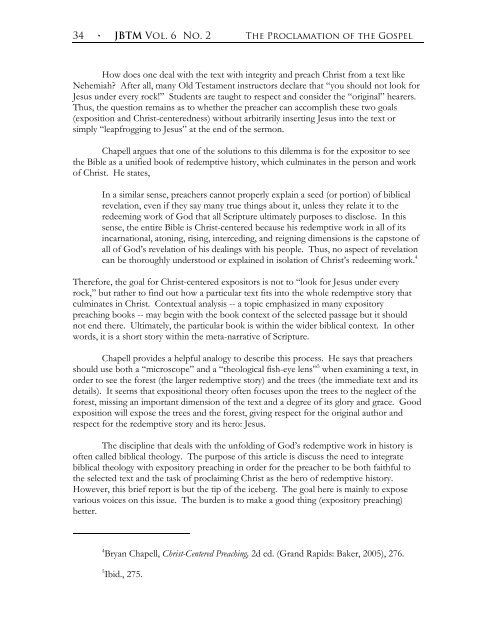0 jbtm vol. 6, no. 2 the proclamation of the gospel - Baptist Center for ...
0 jbtm vol. 6, no. 2 the proclamation of the gospel - Baptist Center for ...
0 jbtm vol. 6, no. 2 the proclamation of the gospel - Baptist Center for ...
Create successful ePaper yourself
Turn your PDF publications into a flip-book with our unique Google optimized e-Paper software.
34 ٠ JBTM Vol. 6 No. 2 The Proclamation <strong>of</strong> <strong>the</strong> Gospel<br />
How does one deal with <strong>the</strong> text with integrity and preach Christ from a text like<br />
Nehemiah? After all, many Old Testament instructors declare that “you should <strong>no</strong>t look <strong>for</strong><br />
Jesus under every rock!” Students are taught to respect and consider <strong>the</strong> “original” hearers.<br />
Thus, <strong>the</strong> question remains as to whe<strong>the</strong>r <strong>the</strong> preacher can accomplish <strong>the</strong>se two goals<br />
(exposition and Christ-centeredness) without arbitrarily inserting Jesus into <strong>the</strong> text or<br />
simply “leapfrogging to Jesus” at <strong>the</strong> end <strong>of</strong> <strong>the</strong> sermon.<br />
Chapell argues that one <strong>of</strong> <strong>the</strong> solutions to this dilemma is <strong>for</strong> <strong>the</strong> expositor to see<br />
<strong>the</strong> Bible as a unified book <strong>of</strong> redemptive history, which culminates in <strong>the</strong> person and work<br />
<strong>of</strong> Christ. He states,<br />
In a similar sense, preachers can<strong>no</strong>t properly explain a seed (or portion) <strong>of</strong> biblical<br />
revelation, even if <strong>the</strong>y say many true things about it, unless <strong>the</strong>y relate it to <strong>the</strong><br />
redeeming work <strong>of</strong> God that all Scripture ultimately purposes to disclose. In this<br />
sense, <strong>the</strong> entire Bible is Christ-centered because his redemptive work in all <strong>of</strong> its<br />
incarnational, atoning, rising, interceding, and reigning dimensions is <strong>the</strong> capstone <strong>of</strong><br />
all <strong>of</strong> God’s revelation <strong>of</strong> his dealings with his people. Thus, <strong>no</strong> aspect <strong>of</strong> revelation<br />
can be thoroughly understood or explained in isolation <strong>of</strong> Christ’s redeeming work. 4<br />
There<strong>for</strong>e, <strong>the</strong> goal <strong>for</strong> Christ-centered expositors is <strong>no</strong>t to “look <strong>for</strong> Jesus under every<br />
rock,” but ra<strong>the</strong>r to find out how a particular text fits into <strong>the</strong> whole redemptive story that<br />
culminates in Christ. Contextual analysis -- a topic emphasized in many expository<br />
preaching books -- may begin with <strong>the</strong> book context <strong>of</strong> <strong>the</strong> selected passage but it should<br />
<strong>no</strong>t end <strong>the</strong>re. Ultimately, <strong>the</strong> particular book is within <strong>the</strong> wider biblical context. In o<strong>the</strong>r<br />
words, it is a short story within <strong>the</strong> meta-narrative <strong>of</strong> Scripture.<br />
Chapell provides a helpful analogy to describe this process. He says that preachers<br />
should use both a “microscope” and a “<strong>the</strong>ological fish-eye lens” 5 when examining a text, in<br />
order to see <strong>the</strong> <strong>for</strong>est (<strong>the</strong> larger redemptive story) and <strong>the</strong> trees (<strong>the</strong> immediate text and its<br />
details). It seems that expositional <strong>the</strong>ory <strong>of</strong>ten focuses upon <strong>the</strong> trees to <strong>the</strong> neglect <strong>of</strong> <strong>the</strong><br />
<strong>for</strong>est, missing an important dimension <strong>of</strong> <strong>the</strong> text and a degree <strong>of</strong> its glory and grace. Good<br />
exposition will expose <strong>the</strong> trees and <strong>the</strong> <strong>for</strong>est, giving respect <strong>for</strong> <strong>the</strong> original author and<br />
respect <strong>for</strong> <strong>the</strong> redemptive story and its hero: Jesus.<br />
The discipline that deals with <strong>the</strong> unfolding <strong>of</strong> God’s redemptive work in history is<br />
<strong>of</strong>ten called biblical <strong>the</strong>ology. The purpose <strong>of</strong> this article is discuss <strong>the</strong> need to integrate<br />
biblical <strong>the</strong>ology with expository preaching in order <strong>for</strong> <strong>the</strong> preacher to be both faithful to<br />
<strong>the</strong> selected text and <strong>the</strong> task <strong>of</strong> proclaiming Christ as <strong>the</strong> hero <strong>of</strong> redemptive history.<br />
However, this brief report is but <strong>the</strong> tip <strong>of</strong> <strong>the</strong> iceberg. The goal here is mainly to expose<br />
various voices on this issue. The burden is to make a good thing (expository preaching)<br />
better.<br />
4 Bryan Chapell, Christ-<strong>Center</strong>ed Preaching, 2d ed. (Grand Rapids: Baker, 2005), 276.<br />
5 Ibid., 275.


